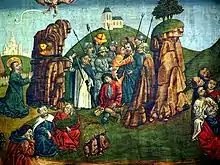Secret handshake
A secret handshake is a distinct form of handshake or greeting which indicates membership in or loyalty to a club, clique or subculture and friends. The typical secret handshake involves placing one's fingers or thumbs in a particular position, one that will be recognized by fellow members while seeming to be a normal handshake to non-members. This is most frequently associated in the popular consciousness with college fraternities, fraternal orders and secret societies.[1]
A secret handshake can also be a useful form of familiar interaction between friends, colleagues, and family members. As a form of cryptography, secret handshakes are shared only with select and elect peoples. Usually a secret handshake has underlying meanings that differ from person to person. Secret handshakes involve a precise, sometimes complex series of movements and contact between two individuals or even a group. Usually, these movements involve the primary use of hands, but could also involve a series of touching feet, elbows, or in some cultures a friendly kiss.
Historical usage

Secret handshakes cannot be traced back to a specific dated origin, but it can be determined that it is as old as any form of greeting or identification. In the Roman mystery religion Mithraism, members were initiated with a handshake, and members were known as syndexioi (united by the handshake).[2] The Freemason Society is one of the most well-known and longstanding implementations of secret handshakes. However, Biblical records also show evidence of secret greetings or handshakes. Although not a technical handshake, the account in the Gospel of John of the kiss of Judas, by which Judas Iscariot betrayed Jesus, can be viewed as a form of secret greeting.
The Freemasons have at least 12 known universal secret handshakes that were implemented in their society. However, there are believed to be many more unrecorded masonic secret handshakes. The secretiveness of this society is prevalent in their greetings. Fellow masons shake hands using secret handshakes, but within the society, apprentices and masters have distinctly different handshakes to identify one from another. Additionally, the Freemasons make use of the aforementioned secret signals to subtly indicate who is of what level. For instance, one handshake used between a master from an apprentice includes distinct touches on the knuckles.
Modern usage
Handshakes are very common even today. The usage of secret handshakes in modern society is much more informal compared to the historical usage of secret handshakes. Where historically, a secret handshake would have a more formal, serious tone, today, secret handshakes are shared by mostly people in grade school who share a friendship type relational bond with one another. Secret handshakes are not commonly used to gain access to secret meetings today, but are more commonly used in an informal setting. Most likely one will see young school-aged children exchanging a complex, whimsical secret handshake on the playground during break time.
The most common modern term used to identify modern is the word ‘dap’ or dap greeting. This term is used to collectively identify most secret handshakes used today, and usually includes a fist bump somewhere in the sequence of contacts.
References
- "Secret Masonic Handshakes, Passwords, Grips And Signs Of Blue Lodge Masonry". Ephesians 5:11. Retrieved 3 March 2012.
- M. Clauss, The Roman cult of Mithras, p. 42: "That the hand-shaken might make their vows joyfully forever"